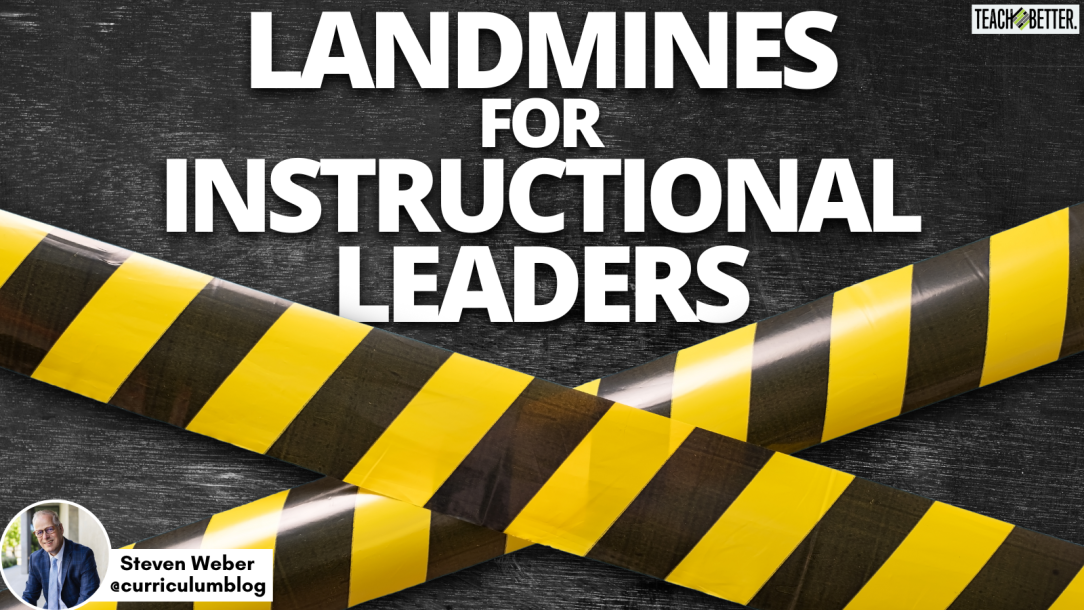TL;DR:
- Instructional leaders must avoid common landmines in their role, such as prioritizing everything as important, lacking clarity in implementation plans, avoiding conflict, focusing solely on data instead of individuals, and dealing with curriculum clutter.
- To overcome these challenges, instructional leaders should provide clarity and prioritize effectively, embrace healthy conflict for curriculum improvement, balance data-driven decision-making with a focus on individual students, and address curriculum clutter to enhance teaching and learning.
- Instructional leaders need courage, vision, and perseverance to support teaching and learning successfully, and by avoiding these landmines, they can navigate the challenges of instructional leadership and make a positive impact.
As a child, my friends and I spent hours playing a video game called Pitfall. Throughout the game, players would attempt to avoid quicksand, rolling logs, crocodiles, snakes, tar pits, scorpions, campfires, and other hazards. Instructional leaders may not face crocodiles or scorpions, but there are landmines that should be avoided. Instructional leaders cannot afford to get stuck in a landmine, because students and families are counting on their guidance.
Landmine #1: Everything Is Important (and on Fire)
Teachers are often overwhelmed by the number of spinning plates they must balance and keep in the air throughout the week. Curriculum guides may outline what each student should know and be able to do. Teachers may also be equipped with prioritized standards, common formative assessments, and state standards. The old saying holds true, ‘If everything is important, then nothing is important.’ Instructional leaders must help teachers see what is most important. “It’s the ‘ladder against the wrong wall’ syndrome meaning we climb the proverbial ladder of success only to find that it’s leaning against the wrong wall” (Covey, Merrill, & Merrill, 1994, p. 138).
When an instructional leader shares three new journal articles, a book study, and offers a flavor-of-the-month professional development (PD), they have fallen into Landmine #1. Instructional leaders should read the room and listen to the needs of teachers and students. When instructional leaders are present and visible in classrooms, they will be proactive rather than reactive. Instructional leaders know that every teacher does not have the same needs and clarity precedes commitment.
A curriculum guide may provide guidance, but instructional leaders consistently provide clarity, which leads to focused action. Click To TweetLandmine #2: Lack of Clarity
Curriculum leaders are adept at developing a curriculum plan, but many struggle to communicate an implementation plan. This landmine leads to frustration, anxiety, confusion, and disjointed curriculum implementation. Students cannot afford for instructional leaders to fall into this trap, because it has a far-reaching impact on student growth.
Culberhouse (2021) wrote, “Urgency without clarity creates chaotic movement. Urgency with clarity creates focused action.” If a district leader has twenty schools, then simply increasing the level of urgency is not going to support focused action. An implementation plan must be communicated and the goals must be shared multiple times. Imagine playing the game of basketball without a basket on either end of the court. Both teams would be playing offense and defense without a basket to shoot at and without a scoreboard. In the absence of clarity, it is difficult for teachers and administrators to know if they are ahead or behind. Clarity empowers teachers to pivot and make instructional decisions that meet the needs of each learner.
Without clarity of purpose and clear goals, it is easy for school teams to drift. When school teams drift from a common purpose the aims of education become blurred. A curriculum guide may provide guidance, but instructional leaders consistently provide clarity, which leads to focused action.
Landmine #3: Fear of Conflict
Teacher teams and district curriculum teams enjoy discussing the strengths of the curriculum. Sitting in a circle and singing ‘Curriculum Kumbaya’ is preferred over conflict. When an instructional leader avoids conflict and tries to maintain the status quo, it can hurt the very students we serve. Rather than falling into this landmine, instructional leaders should embrace conflict.
Teachers and administrators should be equipped to challenge the written curriculum. Feedback forms, focus groups, SWOT analysis, and district meetings are some examples of allowing educators to address the following questions:
- What is working?
- What is not working?
- What would I change in the curriculum?
- How is the curriculum supporting students in my classroom/school?
- What is missing from the curriculum?
- What does the data indicate we should do next?
Healthy conflict can lead to curriculum revision, support documents, clarity, and most importantly improved outcomes for students. Teachers and administrators should avoid personal attacks or attempts to determine which school has better teachers. “The courage to address tough topics comes from a deep commitment. No deep commitment, no hard dialogue” (Muhammad & Hollie, 2012). Are your school teams committed?
Landmine #4: Focus on Data Over People
It is common for a first-year superintendent or principal to focus on data. Data is part of a school or district leader’s evaluation and they feel a sense or urgency or moral imperative to support all learners. The desire to see student growth, empowered teachers, quality instructional materials, and high-performing schools is not a sin. The derailing behavior is when instructional leaders fall into Landmine #4.
School data can become a landmine when we view students as numbers. Behind each data point is a student’s face and each student has a unique story. If an instructional leader is pleased because 60% of the students are reading at grade level, it means 40% of the students are not reading at grade level. When a high school has a 90% graduation rate, it means 10% of the students did not graduate with their cohort. When instructional leaders focus on people, there will be a need to ask additional questions, seek collective commitments, provide academic and behavioral support, and analyze the curriculum. Data-driven decision-making can support continuous improvement. In order to avoid this landmine, instructional leaders need to remember that students are more than a number.
[scroll down to keep reading]Landmine #5: Curriculum Clutter
Curriculum clutter impacts teaching and learning and can negatively impact student understanding. This landmine is common in school districts. Does your school district have a curriculum review cycle? According to Linda Darling-Hammond (2010-2011), “A quality curriculum alters a student’s academic trajectory; it is a more powerful determinant of eventual achievement than their academic readiness when they enter school” (p. 23).
Curriculum clutter comes in many forms, including initiative fatigue. “When the number of initiatives increases while time, resources, and emotional energy are constant, then each new initiative – no matter how well conceived or well-intentioned – will receive fewer minutes, dollars, and ounces of emotional energy than its predecessors” (Reeves, 2010). “All learners benefit from and should receive instruction that reflects clarity about purposes and priorities of content” (Tomlinson & McTighe, 2006, p. 6). Instructional leaders can become consumed with coverage, pacing, formative assessments, and grades. If curriculum clutter is not examined, it could lead to teachers feeling overwhelmed and student misconceptions.
Navigation, Survival, and Swinging Ropes
In the Intellivision game (1982), Pitfall Harry approached scorpions, campfires, and crocodiles with a sense of urgency. Instructional leaders may not experience these same obstacles, but they will need courage, vision, and perseverance in order to support teaching and learning. Instructional leaders can avoid landmines by using the strategies outlined in this article. The importance of instructional leadership has been described for decades.
Avoiding these landmines will help you navigate the challenges of instructional leadership. The rapid pace of change in schools will create additional pitfalls and landmines. Reflect on your current strengths as an instructional leader and embrace the mindset of Pitfall Harry!
References
Covey, S. R., Merrill, A. R., & Merrill, R. R. (1994). First things first: to live, to love, to learn, to leave a legacy. Simon & Schuster.
Culberhouse, D. (2021). Twitter. Retrieved from https://twitter.com/DCulberhouse/status/1418363234906611712.
Darling-Hammond, L. (2010-2011). Soaring systems. American Educator, 34(4). 20-23.
Muhammad, A., & Hollie, S. (2012). The will to lead, the skill to teach: Transforming schools at every level. Solution Tree Press.
Reeves, D. (2010). Transforming professional development into student results. ASCD.
Tomlinson, C., & McTighe, J. (2006). Integrating differentiated instruction and understanding by design: Connecting content and kids. ASCD.
About Steven Weber
Dr. Steven Weber is a curriculum leader. He has served on multiple state and national boards. His areas of research include curriculum design, multiplying leaders, professional learning, and school leadership.




